|
|
 |
Fiche d'espèce de Copépode |
|
|
Calanoida ( Ordre ) |
|
|
|
Clausocalanoidea ( Superfamille ) |
|
|
|
Aetideidae ( Famille ) |
|
|
|
Paivella ( Genre ) |
|
|
| |
Paivella inaciae Vervoort, 1965 (F,M) | |
| | | | | | | Syn.: | Aetideus atlanticus Calef & Grice, 1965 (p.634, figs.F, Rem.) | | | | Ref.: | | | Vervoort, 1965 (p.201, figs.F,M, Rem.); Binet & Dessier, 1971 (p.427, Rem.); Bradford & Jillett, 1980 (p.63); Björnberg & al., 1981 (p.630, figs.F,M); Markhaseva, 1996 (p.233, figs.F,M); Bradford-Grieve & al., 1999 (p.879, 919, 922, figs.F,M) | 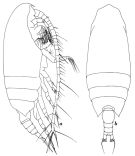 Issued from : W. Vervoort in Atlantide Report, 1965, 8. [p.201, Fig.36] Female (from off Nigeria): a, habitus (lateral right side); b, idem (dorsal). Nota: Head and 1st thoracic somite fused, 4th and 5th fused. Proportional lengths of prosome and urosome as 17:5. Above the rostral base the pair of hairs of the frontal organ is clerly visible. Proportional lengths of abdominal somites and furca as 36:20:15:12:17 = 100. Caudal rami twice as long as wide; each ramus with 4 strong apical setae and a ventral appendicular seta, strongly curved. A1 23-segmented.
|
 Issued from : W. Vervoort in Atlantide Report, 1965, 8. [p.203, Fig.37] Female: a, anterior part cephalothorax (lateral); b, posterior part cephalothorax and abdomen (lateral right side); c, idem (dorsal); d, forehead (ventral).
|
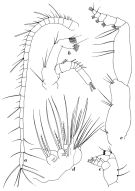 Issued from : W. Vervoort in Atlantide Report, 1965, 8. [p.204, Fig.38] Female: a, A1; b, A2; c, Md (mandibular palp); d, Mx2; e, Mxp. Nota: Endopodite of A 2 2-segmented; small coxa with 1 internal seta; basis with 2 fine setae near the insertion of the endopodite; 2nd endopodal segment with 8 setae on the internal lobe and 6 plus 1 appendicular setae on the extarnal lobe. Basis and coxa of the mandibular palp with 2 strong, external, spiniform setae; endopodite 2-segmented with 2 setae on the 1st segment and 9 plus 1 appendicular on the 2nd segment; exopodite 5-segmented. Mx2 with 2 praecoxal and 2 coxal endites; the proximal three of these endites with 2 long setae and 1 short seta each; there is only asingle basipodal endite, bearing a considerably thickened, spinulose spine and 2 fine setae; apparently 3 endopodal segments, with a total of 6 setae. All endites, with the exception of that arising from the basis, are set with some rows of fine spinules. Coxa and basis of Mxp of about the same length; endopodite 5-segmented (setal formula: 4, 4, 3, 3 + 1 external, 4, respectively).
|
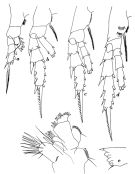 Issued from : W. Vervoort in Atlantide Report, 1965, 8. [p.206, Fig.39] Female: a, P1; b, P2; c, P3; d, P4; e, Md (cutting edge); f, Mx1. Nota: Praecoxal arthrite with 9 strong spiniform teeth and 4 fine setiform spines; epipodite of the coxa with 9 setae; coxal endite with 3 setae; basal endite with 4 setae; exite badly developed without seta; basipodite with 4 setae, one of which appears to be appendicular; endopodite indistinctly 3-segmented (setal formula: 2, 3, 5, respectively); exopodite small with 11 setae.
|
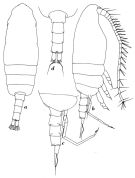 Issued from : W. Vervoort in Atlantide Report, 1965, 8. [p.207, Fig.40] Male: a, habitus (dorsal); b, idem (lateral right side); c, posterior part cephalothorax with P5 and urosome (lateral right side). Nota: Rostrum almost as in female, the points are slightly shorter. Urosome with 5 somites; The urosomal segments and furca in the proportional lengths 15:21:21:23:5: 15 = 100. Genital somite with genital slit on the left side.
|
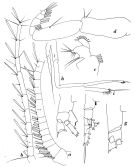 Issued from : W. Vervoort in Atlantide Report, 1965, 8. [p.209, Fig.41] Male: a-b, A1; c, Mx1; d, Mxp; e, P1; f, P2; g, P4; h, P5 (l = left leg; r = right leg); i, apex of left P5. Nota: mandibular palp almost as in female, but setae densely plumose. Mx1 reduced; praecoxal arthrite as a more or less triangular structure, without setae or spines; coxal endite absent; coxal exite (epipodite) with 5 long, plumose setae; basal endite with 2 nude setae; exite absent; basipodite with 3 fine setae; endopodite reduced and indistinctly 3-segmented, with 3 normal and 5 or 6 fine setae; exopodite normally developed with 10 long plumose setae. Mx2 strongly reduced. The fifth legs both uniramose. P1 to P4 as in female but for the following differences; 1- P1: the 1st and 2nd exopodal segments completely fused; 2- P2: The endopodite has an incomplete segmentation in its proximal part; 3- P4: There are no spinules on the posterior aspect of the coxa, there is no seta at the internal margin of the coxa and the internal chitinized ridge is small (p.210).
|
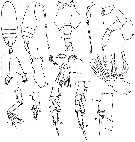 issued from : G.W. Calef & G.D. Grice inBull. mar. Sci., 1965, 15 (3). [p.635, Figs.1-15]. Female (from NW Equatorial Atlantic): 1-2, habitus (dorsal and lateral, respectively); 3, 5th thoracic segment and urosome (dorsal); 4, forehead (ventral); 5, A1; 6, A2; 7, Md (mandibular palp); 8, Md (gnathobase); 9, Mx1; 10, Mx2; 11, Mxp; 12-14, P1 to P3; 15, basipodal segment of P4. Nota: A1 23-segmented, reaching the 2nd abdominal segment (8th and 9th, 24th and 25 segments fused). Rostrum bifid not visible in dorsal view.
|
 issued from : W. Vervoort in Atlantide Report, 1965, 8. [p.205]. Female: Setal (Arabic ) and spinal (Roman) formula of swimming legs P1 to P4. Differences in the male, see text above.
|
 Paivella inaciae Paivella inaciae female: 1 - Genital segment without lateral projections (dorsal view).
| | | | | Ref. compl.: | | | Park, 1970 (p.476); Bainbridge, 1972 (p.61, Appendix Table I: vertical distribution vs day/night, Table II: %); Binet & al., 1972 (p.69); Binet, 1979 (p.400); Dessier, 1979 (p.205); Medellin-Mora & Navas S., 2010 (p.265, Tab. 2) | | | | NZ: | 3 | | |
|
Carte de distribution de Paivella inaciae par zones géographiques
|
| | | | Loc: | | | SW Atlant., Congo, Nigeria, G. of Guinea, Ivorian shelf, Caribbean Sea, Caribbean Colombia, off Amazon.
Type locality: 5°56'N, 4°26'E. | | | | N: | 12 | | | | Lg.: | | | (16) F: 1,46-1,42; M: 1,15; (257) F: 1,45; (258) F: 1,44; 1,4; {F: 1,40-1,46; M: 1,15} | | | | Rem.: | épipélagique.
Voir aussi les remarques en anglais | | | Dernière mise à jour : 30/06/2016 | |
|
|
 Toute utilisation de ce site pour une publication sera mentionnée avec la référence suivante : Toute utilisation de ce site pour une publication sera mentionnée avec la référence suivante :
Razouls C., Desreumaux N., Kouwenberg J. et de Bovée F., 2005-2025. - Biodiversité des Copépodes planctoniques marins (morphologie, répartition géographique et données biologiques). Sorbonne Université, CNRS. Disponible sur http://copepodes.obs-banyuls.fr [Accédé le 30 novembre 2025] © copyright 2005-2025 Sorbonne Université, CNRS
|
|
 |
 |










